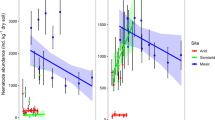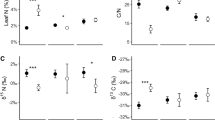Abstract
Climate change may affect hemisparasiticOrobanchaceae (ex-Scrophulariaceae) both directly through impacts on hemiparasite physiology and indirectly through impacts on host plants. This dual action suggests particular sensitivity of the parasite to climate change and any associated impacts on hosts and other members of the community. While little research has addressed the responses of parasitic plants to climate change in natural environments, impacts are predicted from controlled environment studies together with a knowledge of the key ecophysiological traits of hemiparasiticOrobanchaceae, in particular ofStriga species, which are important weeds in semi-arid tropical agro-ecosystems, andRhinanthus species, which can be important components of (principally) grassland communities in the northern temperate zone. The main mode of important components of (principally) grassland communities in the northern temperate zone. The main mode of action of both elevated CO2 and warming will be through changes in photosynthesis and stomatal functioning. Enhanced photosynthesis of the hemiparasite and host will increase parasite carbon gains but may also increase the demand for host mineral nutrients. Mineral nutrition may, therefore, mediate the impacts of climate change on host-parasite associations. The relative insensitivity of hemiparasite stomata to elevated CO2 suggests that high stomatal conductances may be maintained and thus solute uptake may become limited by soil drying driven by higher rates of evapotranspiration and reduced precipitation. Climate change impacts on host-parasite interactions at the individual level will ultimately affect hemiparasite impacts at the community level. Community impacts will be greatest where climate change considerably favours hemiparasite populations or, conversely, causes them to disappear from communities where they were formerly abundant. Impacts will further be mediated by climate impacts on hosts, and the natural enemies of hosts and parasites alike. Further, the wide host range of many root hemiparasitic plants may facilitate migration of their populations through new communities under a changing climate.
Similar content being viewed by others
References
Adams P., Thomas J.C., Vernon D.M., Bohnert H.J. &Jensen R.G. (1992): Distinct cellular and organismic responses to salt stress.Pl. Cell Physiol. 33: 1215–1223.
Adler L.S. (2000): Alkaloid uptake increases fitness in a hemiparasitic plant via reduced herbivory and increased pollination.Amer. Naturalist 156: 92–99.
Arslanian R.L., Harris G.H. &Stermitz F.R. (1990): New quinolizidine alkaloids fromLupinus argenteus and its hosted root parasiteCastilleja sulphurea. Stereochemistry and conformation of some naturally occurring cyclic carbolamides.J. Org. Chem. 55: 1204–1210.
Ayres M.P. &Lombardero M.J. (2000): Assessing the consequences of global; change for forest disturbance from herbivores and pathogens.Sci. Total Environm. 262: 263–268.
Bezemer T.M. &Jones T.H. (1998): Plant-insect herbivore interactions in elevated atmospheric CO2: quantitative analyses and guild effects.Oikos 82: 212–222.
Bouwmeester H.J., Matusova R., Zhonghui S. &Beale M.H. (2003): Secondary metabolite signalling in host-parasite plant interactions.Curr. Opin. Pl. Biol. 6: 358–364.
Callaway R.M. &Pennings S.C. (1998): Impact of a parasitic plant on the zonation of two salt marsh perennials.Oecologia 114: 100–105.
Ceulemans R. &Mousseau M. (1994): Effects of elevated CO2 on woody plants.New Phytol. 127: 425–446.
Coviella C.E. &Trumble J.T. (1999): Effects of elevated atmospheric carbon dioxide on insect-plant interactions.Conservation Biol. 13: 700–712.
Cubasch U. et al. (2001): Projections of future climate change. In:Houghton J.T., Ding Y., Griggs D.J., Noguer M., van der Linden P.J., Dai X., Maskell K. &Johnson C.A. (eds.),Climate change 2001: The scientific basis, Cambridge University Press, Cambridge, pp. 525–582.
Davies D.M., Graves J.D., Elias C.O. &Williams P.J. (1997): The impact ofRhinathus spp. on sward productivity and composition: implications for the restoration of species-rich grasslands.Biol. Conservation 82: 98–93.
Drake B.G., Gonzalez-Meler M.A. &Long S.P. (1997): More efficient plants: a consequence of rising CO2?Annual Rev. Pl. Physiol. Pl. Molec. Biol. 48: 609–639.
Fitter A. (1999): Roots as dynamics systems: the developmental ecology of roots and root systems. In:Press M.C., Scholes J.D. &Barker M.G. (eds.),Physiological plant ecology, Blackwell Science, Oxford, pp. 115–131.
Frost D.L., Gurney A.L., Press M.C. &Scholes J.D. (1997):Striga hermonthica reduces photosynthesis in sorghum: the importance of stomatal limitations a potential role for ABA?Pl. Cell Environm. 20: 483–492.
Gibson C.C. &Watkinson A.R. (1989): The host range and selectivity of a parasitic plant:Rhinanthus minor L.Oecologia 78: 401–406.
Gibson C.C. &Watkinson A.R. (1992): The role of the hemiparasitic annualRhinathus minor in determining grassland community structure.Oecologia. 89: 62–68.
Graves J.D., Press M.C. &Stewart G.R. (1989): A carbon balance model of theSorghum-Striga hermonthica host-parasite association.Pl. Cell Environm. 12: 101–107.
Hwangbo J.K., Seel W.E. &Woodin S.J. (2003): Short-term exposure to elevated atmospheric CO2 benefits the growth of a facultative annual root hemiparasite,Rhinanthus minor (L.), more than that of its host,Poa pratensis (L.).J. Exp. Bot. 54: 1951–1955.
Källen E., Kattsov V., Walsh J. &Weatherhead E. (2001):Report from the Arctic Climate Impact Assessment Modelling and Scenarios Workshop, January 29–31, 2001. Stockholm, Sweden. Available at http://www.acia.uaf.edu.
Karakas B., Oziasakins P., Stushnoff C., Suefferheld M. &Rieger M. (1997): Salinity and drought tolerance of mannitol-accumulating transgenic tobacco.Pl. Cell Environm. 20: 609–616.
Kelly C.K., Venable D.L. &Zimmerer K. (1988). Host specialization inCuscuta costaricensis: An assessment of host use relative to host availability.Oikos 53: 315–320.
Kriticos D.J., Sutherst R.W., Brown J.R., Adkins S.W. &Maywald G.F. (2003): Climate change and the potential distribution of an invasive alien plant:Acacia nilotica ssp.indica in Australia.J. App. Ecol. 40: 111–124.
Lewis D.H. (1984): Physiology and metabolism of alditols. In:Lewis D.H. (ed.),Storage carbohydrates in vascular plants, Cambridge University Press, Cambridge, pp. 157–179.
Long S.P. (1999): Understanding the impacts of rising CO2: the contribution of environmental physiology. In:Press M.C., Scholes J.D. &Barker M.G. (eds.),Physiological plant ecology, Blackwell Science Ltd, Oxford, pp. 263–282.
Makino A. &Mae T. (1999): Photosynthesis and plant growth at elevated levels of CO2.Pl. Cell. Physiol. 40: 999–1006.
Marko M.D. &Stermitz F.R. (1997): Transfer of alkaloids fromDelphinium toCastilleja via root parasitism. Norditerpenoid alkaloid analysis by electrospray mass spectrometry.Biochem. Syst. Ecol. 25: 279–285.
Marvier M.A. (1998): Parasite impacts on host communities: Plant parasitism in a California coastal prairie.Ecology 79: 2616–2623.
Matthies D. &Egli P. (1999): Response of a root hemiparasite to elevated CO2 depends on host type and soil nutrients.Oecologia 120: 156–161.
Mead E.W., Looker M., Gardner D.R. &Stermitz F.R. (1992): Pyrrolizidine alkaloids ofLiatris punctata and its root parasite,Castilleja intergra.Phytochemistry 31: 3255–3257.
Parmesan C. (1996): Climate and species’ range.Nature 382: 765–766.
Pate J.S., Davidson N.J., Kuo J. &Milburn J.A. (1990): Water relations of the root hemiparasiteOlax phyllanthi (Labill.)R.Br. (Olacaceae) and its multiple hosts.Oecologia 84: 186–193.
Pennings S.C. &Callaway R.M. (1996): Impact of a parasitic plant on the structure and dynamics of salt marsh vegetation.Ecology 77: 1410–1419.
Phoenix G.K. &Press M.C. (2005): Linking physiological traits to impacts on community structure and function: the role of root hemiparasiticOrobanchaceae (ex-Scrophulariaceae).J. Ecol. 93: 67–78.
Press M.C., Graves J.D. &Stewart G.R. (1988): Transpiration and carbon acquisition in root hemiparasitic angiosperms.J. Exp. Bot. 39: 1009–1014.
Press M.C., Nour J.J., Bebawi F.F. &Stewart G.R. (1989): Antitranspirant induced heat stress in the parasitic plantStriga hermonthica — a novel method of control.J. Exp. Bot. 40: 585–591.
Press M.C. & Phoenix G.K. (2005): Impacts of parasitic plants on natural communities.New Phytol. Early on-line publication: doi: 10.1111/j.1469-8137.2005.01358.x.
Press M.C., Touhy J.M. &Stewart G.R. (1987): Gas exchange characteristics of theSorghum-Striga host-parasite association.Pl. Physiol. 84: 814–819.
Press M.C. &Whittaker J.B. (1993): Exploitation of the xylem stream by parasitic organisms.Philos. Trans., Ser. B. 341: 101–111.
Pritchard S.G., Rogers H.H., Prior S.A. &Peterson C.M. (1999): Elevated CO2 and plant stucture: a review.Global Change Biol. 5: 807–837.
Quested H.M., Press M.C., Callaghan T.V. &Cornelissen J.H.C. (2002): The hemiparasitic angiospermBartsia alpina has the potential to accelerate decomposition in sub-arctic communities.Oecologia 130: 88–95.
Quested H.M., Press M.C. &Callaghan T.V. (2003a): Litter of the hemiparasiteBartsia alpina enhances plant growth: evidence for a functional role in nutrient cycling.Oecologia 135: 606–614.
Quested H.M., Cornelissen J.H.C., Press M.C., Callaghan T.V., Aerts R., Trosien F., Riemann P., Gwynn-Jones D., Kondratchuk A. &Jonasson S.E. (2003b): Decomposition of sub-arctic plants with differing nitrogen economies: a functional role for hemiparasites.Ecology 84: 3209–3221.
Ramlan M.F. &Graves J.D. (1996): Estimation of the sensitivity to photoinhibition inStriga hermonthica-infected sorghum.J. Exp. Bot. 47: 71–78
Riopel J.L. &Timko M.P. (1995): Haustorial initiation and differentiation. In:Press M.C. &Graves J.D. (eds.),Parasitic plants, Chapman & Hall, London, pp. 39–79.
Rogers H.H., Runion G.B. &Krupa S.V. (1994): Plant responses to atmospheric CO2 enrichment with emphasis on roots and the rhizosphere.Environm. Pollut. 83: 155–189.
Schneider M.J. &Stermitz F.R. (1990): Uptake of host plant alkaloids by root parasiticPedicularis species.Phytochemistry 29: 1811–1814.
Schulze E.-D. &Ehleringer J.R. (1984): The effect of nitrogen supply on growth and water-use efficiency of xylem tapping mistletoes.Planta 184: 268–275.
Schulze E.-D., Turner N.C. &Glatzel G. (1984): Carbon, water and nutrient relations of two mistletoes and their hosts: a hypothesis.Pl. Cell Environm. 7: 293–299.
Schmidt I.K., Jonasson S., Shaver G.R., Michelsen A. &Nordin A. (2002): Mineralization and distribution of nutrients in plants and microbes in four arctic ecosystems: responses to warming.Pl. & Soil 242: 93–106.
Seel W.E. &Press M.C. (1994): Influence of the host on three sub-Arctic annual facultative root hemiparasites II. Gas exchange characteristics and resource use-efficiency.New Phytol. 127: 37–44.
Seel W.E., Cooper R.E. &Press M.C. (1993): Growth, gas exchange and water use efficiency of the facultative hemiparasiteRhinathus minor associated with hosts differing in foliar nitrogen cencentration.Physiol. Pl. 89: 64–70.
Smith S. &Stewart G.R. (1990): Effects of potassium levels on the stomatal behavior of the hemi-parasiteStriga hermonthica.Pl. Physiol. 94: 1472–1476.
Stermitz F.R., Foderaro T. A. &Li Y. (1993): Iridoid glycoside uptake byCastilleja integra via root parasitism on PenstemonTeucriodes.Phytochemistry 32: 1151–1153.
Sutherst R.W. (2001): The vulnerability of animal and human health to parasites under global change.Int. J. Parasitol. 31: 933–948.
Veteli T.O., Kuokkanen K., Julkunen-Tiitto R., Roininen H. &Tahvanainen J. (2002): Effects of elevated CO2 and temperature on plant growth and herbivore defensive chemistry.Global Change Biol. 8: 1240–1252.
Wand S.J.E., Midgley G.F., Jones M.H. &Curtis P.S. (1999). Responses of wild C4 and C3 grass (Poaceae) species to elevated atmospheric CO2 concentrations: a meta-analytic test of current theories and perceptions.Global Change Biol. 5: 723–741.
Watling J.R. &Press M.C. (1997): How is the relationship between the C4 cerealSorghum bicolour and the C3 root hemiparasitesStriga hermonthica andStriga asiatica affected by elevated CO2?Pl. Cell Environm. 20: 1292–1300.
Watling J.R. &Press M.C. (1998): How does the C4 grassEragrostis pilosa respond to elevated carbon dioxide and infection with the parasitic angiospermStriga hermonthica.New Phytol. 140: 667–675.
Watling J.R. &Press M.C. (2000): Infection with the parasitic angiospermStriga hermonthica influences the response of the C3 cerealOryza sativa to elevated CO2.Global Change Biol. 6: 919–930.
Watling J.R. &Press M.C. (2001): Impacts of infection by parasitic angiosperms on host photosynthesis.Pl. Biol. 3: 244–250.
Author information
Authors and Affiliations
Rights and permissions
About this article
Cite this article
Phoenix, G.K., Press, M.C. Effects of climate change on parasitic plants: the root hemiparasiticOrobanchaceae . Folia Geobot 40, 205–216 (2005). https://doi.org/10.1007/BF02803235
Received:
Revised:
Accepted:
Issue Date:
DOI: https://doi.org/10.1007/BF02803235




